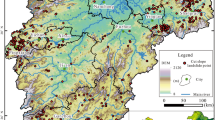Abstract
Within the engineering profession and natural sciences, vulnerability is widely accepted to be defined as the degree of loss (or damage) to a given element or set of elements within the area affected by a threat. The value of vulnerability is expressed nondimensionally between 0 and 1. It is a fundamental component in the evaluation of landslide risk, and its accurate estimation is essential in making a reasonable prediction of the landslide consequences. Obviously, vulnerability to landslides depends not only on the characteristics of the element(s) at risk but also on the landslide intensity. This paper summarizes previous research on vulnerability to landslides and proposes a new quantitative model for vulnerability of structures and persons based on landslide intensity and resistance of exposed elements. In addition, an approximate function is suggested for estimating the vulnerability of persons in structures. Different methods for estimating the vulnerability of various elements to slow or rapid landslides are discussed. Finally, the application of the new model is illustrated through an example.












Similar content being viewed by others
References
Amatruda G, Bonnard C, Castelli M, Forlati F, Giacomelli M, Morelli M, Paro L, Piana F, Pirulli M, Polino R, Prat P, Ramasco M, Scavia C, Bellardone G, Campus S, Durville JL, Poisel R, Preh A, Roth W, Tentschert EH (2004) A key approach: the IMIRILAND project method. In: Bonnard C, Forlati F, Scavia C (eds) Identification and mitigation of large landslide risks in Europe—advances in risk assessment. European Commission Fifth Framework Program. Balkema, Rotterdam, pp 13–44
Australian Geomechanics Society (2000) Landslide risk management concepts and guidelines. Aust Geomech 35:49–92
Cruden DM, Varnes DJ (1996) Landslide types and processes. In: Landslide investigation and mitigation (1996). National Academy Press, Washington, pp 36–75
Dai FC, Lee CF, Ngai YY (2002) Landslide risk assessment and management: an overview. Eng Geol 64:65–87
Duzgun HSB, Lacasse S (2005) Vulnerability and acceptable risk in integrated risk assessment framework. In: Hungr O, Fell R, Couture R, Eberhardt E (eds) Landslide risk management. Balkema, Rotterdam, pp 505–515
Einstein HH (1988) Landslide risk assessment procedure. In proceeding of International Symposium On landslides. Lausanne 2:1075–1090
Fell R (1994) Landslide risk assessment and acceptable risk. Can Geotech J 31:261–272
Fell R, Hartford D (1997) Landslide risk management. In: Cruden, DM and Fell R (eds) Landslide risk assessment. Proceedings of the workshop on landslide risk assessment. Honolulu, February 19–21, pp 51–109
Finlay PJ (1996) The risk assessment of slopes. School of Civil Engineering, University of New South Wales, Australia, PhD thesis
Glade T (2003) Vulnerability assessment in landslide risk analysis. Erde 134:121–138
Glade T, Crozier MJ (2005) The nature of landslide hazard and impact. In: Glade T, Anderson MG, Crozier MJ (eds) Landslide hazard and risk. Wiley, Chichester, pp 43–74
Heinimann HR (1999) Risikoanalyse bei gravitativen Naturgefahren – Fallbeispiele und Daten. Umwelt-Materialen 107/I, Bern
Jia Y, Gao JG (2004) The analysis of death number-ages distribution during the M7.3 earthquake in Haicheng of Liaoning. Earthq Res China 20(4):394–398
Kaynia AM, Papathoma-Köhle M, Neuhäuser B, Ratzinger K, Wenzel H, Medina-Cetina Z (2008) Probabilistic assessment of vulnerability to landslide: application to the village of Lichtenstein, Baden-Württemberg, Germany. Eng Geol 101:33–48
Lee EM, Jones DKC (2004) Landslide risk assessment. Tilford, London
Leone F, Asté JP, Leroi E (1996) Vulnerability assessment of elements exposed to mass-movements: working toward a better risk perception. In: Senneset K (ed) Landslides-Glissements de Terrain. Balkema, Rotterdam, pp 263–270
Leroi, E (1996) Landslide hazard—risk maps at different scales: objectives, tools and development. In: Senneset, K (ed) Landslides. Proceeding of 7th international symposium on landslides, June 17–21, Trondheim, pp 35–51
Ministry of Civil Affairs of the People’s Republic of China (2007) The statistical data of fatality due to natural hazards in 2006. http://jzs.mca.gov.cn/article/gzdt/200711/20071100003277.shtml?2
Ministry of Housing and Urban–Rural Development of PRC (2002) Code for design of building foundation. Ministry of Housing and Urban–Rural Development of PRC, Beijing
Ojeda-Moncayo J, Locat J, Couture R, Leroueil S (2004) The magnitude of landslides: an overview. In: Lacerda W et al. (eds) (2004) Landslides: Evaluation and Stabilization. Proceedings of the Ninth International Symposium on Landslides, June 28–July 2, Rio de Janeiro, Brazil, pp 379–384
Ragozin AL, Tikhvinsky IO (2000) Landslide hazard, vulnerability and risk assessment. In: Bromhead E, Dixon N, Ibsen ML (eds) Proceedings of the 8th International Symposium on Landslides, Cardiff, pp 1257–1262
Remondo J, Bonachea J, Cendrer A (2008) Quantitative landslide risk assessment and mapping on the basis of recent occurrences. Geomorphology 94:496–507
Spence RJS, Kelman I, Calogero E, Toyos G, Baxter PJ, Komorowski JC (2005) Modelling expected physical impacts and human casualties from explosive volcanic eruptions. Natural Hazards and Earth System Sciences 5:1003–1015
Tsai YB, Yu TM, Chao HL, Lee CP (2001) Spatial distribution and age dependence of human-fatality rates from the Chi-Chi, Taiwan, Earthquake of 21 September 1999. Bull Seismol Soc Am 91(5):1289–1309
Uzielli M, Nadim F, Lacasse S, Kaynia AM (2008) A conceptual framework for quantitative estimation of physical vulnerability to landslides. Eng Geol 102:251–256
Varnes DJ (1984) Landslide hazard zonation: a review of principles and practice. Natural Hazards 3:1–63
Wong HN, Ho KKS, Chan YC (1997) Assessment of consequence of landslides. In: Cruden R, Fell R (eds) (1997) Landslide risk assessment. Balkema, Rotterdam, pp 111–149
Zêzere JL, Garcia RAC, Oliveira SC, Reis E (2008) Probabilistic landslide risk analysis considering direct costs in the area north of Lisbon (Portugal). Geomorphology 94:467–495
Acknowledgement
The work presented in this paper was supported by the Research Council of Norway through the Centre of Excellence “International Centre for Geohazards” (ICG) and Norwegian Geotechnical Institute (NGI). The authors gratefully acknowledge the support. The first author wishes to thank China Scholarship Council for funding his stay at ICG/NGI.
Author information
Authors and Affiliations
Corresponding author
Rights and permissions
About this article
Cite this article
Li, Z., Nadim, F., Huang, H. et al. Quantitative vulnerability estimation for scenario-based landslide hazards. Landslides 7, 125–134 (2010). https://doi.org/10.1007/s10346-009-0190-3
Received:
Accepted:
Published:
Issue Date:
DOI: https://doi.org/10.1007/s10346-009-0190-3




